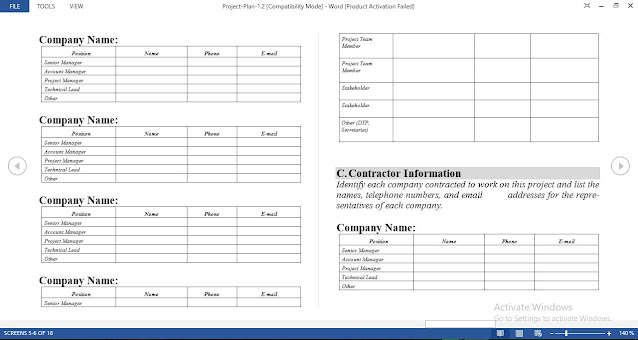 |
| Free Project Plan Template in Word |
Free Project Plan Template in Word
The project plan provides all the information necessary for the execution phase such as the project's goals, objectives, scope of work, milestones, risks and resources. Then, this information helps project managers monitor and control the progress of the project.
Project Plan Instructions
Project Plan Approval Cover Page – Complete the project name (see A.), project working title (see A.), and names of the signatories. The cover page provides space adequate for the approving signature of all management levels in the Commonwealth. Project Plan approval requirements are derived from organization and Commonwealth Policies and Standards as well as Commonwealth of Virginia Code.
General Information – Basic information that identifies the project.
- Project Title – The proper name used to identify this project.
- Project Working Title – The working name or acronym used to identify the project. If an acronym is used, define the specific meaning of each letter.
- Proponent Secretary – The Secretary to whom the proponent agency is assigned to or the Secretary that is sponsoring an enterprise project.
- Proponent Agency – The agency that will be responsible for the management of the project.
- Prepared by – The person(s) preparing this document.
- Date/Control Number – The date the plan is finalized and the change or configuration item control number assigned.
Points of Contact – List those individuals that may be contacted about this project.
- Provide the title, name, organization, phone number, and email address of the following individuals:
- Project Sponsor - An individual, usually part of the organization management team, who makes the business case for the project. This individual has or should have the authority to define project goals, secure resources, and resolve organizational and priority conflicts.
- Program Manager – The individual responsible for the management and coordination of a group of related projects that will include the project being planned.
- Project Manager - The individual appointed and given responsibility for management of the project.
- Procurement Contact – The person responsible for procurement activities from planning to preparation and processing of a requisition, through receipt, acceptance of delivery, and processing of a final invoice for payment.
- Project Team Members - The individuals that report either part time or full time to the project manager and are responsible for the completion of project tasks.
- Stakeholders - Individuals and organizations that are involved in or may be affected by project activities.
- Other – Any person, not listed above, who may be contacted about this project.
Contractor Information – Identify each company contracted to work on this project and list the names, telephone numbers, and email addresses for the representatives of each company. Positions that should be addressed are the Senior Manager, Account Manager, Project Manager, Technical Lead.
Project Plan Summary
- Business Problem – Insert the business problem as stated in the Project Charter (Section C).
- Assumptions - List the Assumptions made about the project in the Project Charter (Section D). List and identify any changes to the original assumptions or additional assumptions made during project planning.
- Project Description - Provide the project approach, specific solution, customer(s), and benefits. The Project Description is stated in the Project Charter (Section E). If there are changes to the description because of project planning, clearly identify the changes or additions made to the project description.
- Project Scope – Provide the Project Scope found in the Project Charter (Section E) and identify any additions or changes resulting from detailed project planning.
- Performance Plan Summary – Measures of success are metrics that measure the success or failure of a project. The measures of success are based on the project scope and objectives. Provide a summary of the Measures of Success from the Performance Plan in Appendix A. In the table below, list the Project Objectives, the Performance Goal for each objective, and briefly describe how the Performance Goal is measured.
- Critical Milestone Summary – Summarize the Project Schedule by listing the Milestones or Events on the critical path of the Project Schedule (Appendix D). The critical path is: a series of activities, which determine the earliest completion time for the project. For each event, provide the Projected Date of Completion and a brief description of the Significance of the Milestone or Event listed.
- Budget Planning Summary – Provide a summary in table form of the expenditures and source of funding for the project during the life of the project. Identify and explain deviations from the approved funding outlined in the Project Charter. This budget does not include expenditures and funding for the life of the asset produced. Lifecycle cost for the asset are addressed in Project Initiation.
- Procurement Plan Summary – Summarize the Procurement Plan for this project. Include information about major procurements, procurement strategies, and projected dates for critical procurement activities.
- Risk Planning Summary – Summarize the Risk Management Strategy for the project. Describe the process for identification of risk, evaluation and prioritization of risk, identification of options for mitigating risk, the process for maintaining the risk plan and risk monitoring, and the responsibilities of individuals.
- Top Ten Risk(s) – Provide a list of the ten highest risks to the project’s success, including the probability of their occurrence, level of impact anticipated, and a brief description of the Mitigation Strategy for each.
Download also:

Post a Comment